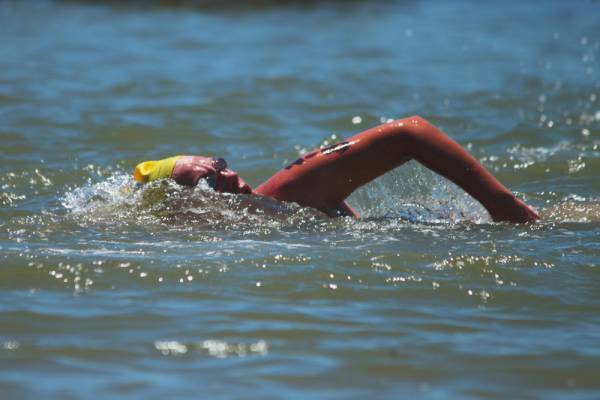Open water swimming presents a myriad of variables that pool swimmers usually don’t need to deal with. From living creatures, visibility, sun exposure, chaffing, feeding, currents, and waves, the list goes on. But there is one variable that received a lot of attention in the last few years and called for a specific committee to establish regulations to ensure the safety of open water swimmers. I am talking about water temperature.
Water temperature played a part in the death of world-class swimmer Fran Crippen at FINA’s 2010 10K series in the United Arab Emirates. In the wake of his death discussions resulted in guidelines that must be followed for an event to be sanctioned by FINA (Federation Internationale de Natation). But while most swimmers don’t need to really know what these guidelines are, recognizing the symptoms and knowing the appropriate medical response to adverse temperature conditions could be a lifesaver, whether in a race, training, or just while swimming open water for fun.
There are two potential scenarios when it comes to water temperature: the water can be too hot or the water can be too cold. With those two scenarios come two body responses: hyperthermia and hypothermia.
Hypothermia
There is a broad range for normal human body temperature, and hypothermia is defined as a temperature below that of the accepted normal human body temperature. While in a body of water, the levels of hypothermia fall into definitions of mild, moderate, and severe.
- Mild hypothermia has two levels of severity. Between 96-99F the symptoms are shivering and impairment to perform coordinated tasks. The basic treatment consists of simple re-warming by blankets and removal from the exposure. If removal is not practical an individual can be wrapped in towels and covered with sand. Between 91-95F the symptoms are shaking, shivering, and mild impairment of the central nervous system indicated by slow thinking and speech difficulty. The basic treatment is the same as the other type of mild hypothermia, but it will take longer to reverse. In addition a warm shower could be beneficial, and the swimmer should be watched closely during recovery.
- Moderate hypothermia is classified as when the body temperature is between 86-90F. At this temperature shivering slows down and stops and there is profound slowing of mental function. Confusion may include hallucinations and paradoxical undressing. Also commonly observed is muscle rigidity, along with jerky motions and irregular heartbeats. The basic treatment in this case includes prevention of further heat loss with the basic measures described above. No aggressive re-warming should be attempted since this results in shunting cold blood into the core and may further drop the core temperature. Evacuation should be considered, to a place where warmed IVs may be performed.
- Severe hypothermia occurs when body temperature is below 86F. The symptoms are drastic and include coma, falling blood pressure, and life-threatening cardiac irregularities. In this situation time is of the essence and this is a true emergency. Evacuate the swimmer and protect him or her from further heat loss. Further attention should be performed by a medical professional.
Hyperthermia
 Hyperthermia is elevated body temperature that occurs when the body absorbs more heat than it dissipates (in the case of a swimmer). Extreme temperature elevation then becomes a medical emergency requiring immediate treatment to prevent disability or death. There are several conditions associated with hyperthermia:
Hyperthermia is elevated body temperature that occurs when the body absorbs more heat than it dissipates (in the case of a swimmer). Extreme temperature elevation then becomes a medical emergency requiring immediate treatment to prevent disability or death. There are several conditions associated with hyperthermia:
- Heat Edema – The main symptom is the swelling of the hands, which usually resolves spontaneously after several days of acclimatization.
- Heat Syncope – Dizziness to the point of fainting in an unacclimatized athlete. It manifests when the swimmer stands up quickly, usually in a state of dehydration. Keeping the swimmer in the supine position with legs elevated, cool liquids (but not iced) and resting in a cool place are the primary ways to care for the swimmer.
- Heat Cramps – Manifest as painful cramps and spasms and are usually cared for by massage, rehydration, and attention to electrolytes. If this is unsuccessful then be attentive to blood sodium content as well as other electrolytes.
- Heat Exhaustion – Usually associated with fatigue, weakness, lack of coordination, mild confusion, agitation, headache, sweating, nausea, vomiting, diarrhea, muscle pain, and cramping. It is associated with a body temperate of less than 104F. Care for this condition includes all the measures described for the milder conditions above, in addition to protection from further exposure by removal to an emergency facility where advanced treatment will be available. During transport spray the swimmer with lukewarm water in a setting of cooling fans and perform cool oral rehydration.
- Heat Stroke – Skin is dry and very warm, there is profound confusion and loss of coordination, and also possibly seizures, coma, and hallucinations. This is a true medical emergency that requires immediate transfer to an emergency facility. Gradual central cooling will be conducted with close attention to organ function and damage.
Prevention of hypothermia and hyperthermia is the key. One of the ways swimmers prepare is by acclimatization to the water they are going to swim in. But in the end, if the water temperature is too high or too low it may be impossible to prevent a drop or increase of body core temperature. Safety is in the prevention, but if you ever find yourself in this situation the measures above should help you stay safe until you can seek medical attention.
Photos courtesy of Shutterstock.






